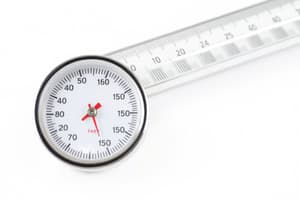Podcast
Questions and Answers
What is the minimum theoretically reachable temperature known as?
What is the minimum theoretically reachable temperature known as?
- Thermal equilibrium
- Liquid nitrogen
- Absolute zero (correct)
- Freezing point
What was invented by Galileo Galilei in 1592?
What was invented by Galileo Galilei in 1592?
- Liquid-in-glass thermometer (correct)
- Resistance Temperature Detector
- Liquefied gas thermometer
- Thermocouple
Which principle does a thermocouple rely on?
Which principle does a thermocouple rely on?
- Absorption of light
- Conduction of metals
- Centrifugal force
- Thermoelectric current (correct)
Which term describes the process of measuring local temperature?
Which term describes the process of measuring local temperature?
How does increased temperature affect molecular motion?
How does increased temperature affect molecular motion?
What process describes the movement of heat in a fluid due to density differences?
What process describes the movement of heat in a fluid due to density differences?
Who invented the first mercury thermometer?
Who invented the first mercury thermometer?
What is the primary function of bistate/phase change sensors?
What is the primary function of bistate/phase change sensors?
Which temperature range do mercury-filled systems operate within?
Which temperature range do mercury-filled systems operate within?
What does a thermocouple use to measure temperature?
What does a thermocouple use to measure temperature?
Which effect is NOT associated with a thermocouple?
Which effect is NOT associated with a thermocouple?
What is the response time typical for bistate/phase change sensors?
What is the response time typical for bistate/phase change sensors?
How does the Seebeck voltage in a thermocouple get produced?
How does the Seebeck voltage in a thermocouple get produced?
What material forms the basis of bistate/phase change sensors?
What material forms the basis of bistate/phase change sensors?
What is a major use of temperature labels or stickers?
What is a major use of temperature labels or stickers?
What is the primary method of energy transfer to the surface mentioned in the content?
What is the primary method of energy transfer to the surface mentioned in the content?
At what temperature range is mercury a liquid?
At what temperature range is mercury a liquid?
Which type of thermometer uses a bimetallic element?
Which type of thermometer uses a bimetallic element?
What is the purpose of bonding two strips of dissimilar metals in a bimetal strip?
What is the purpose of bonding two strips of dissimilar metals in a bimetal strip?
What range of temperatures can filled-bulb systems measure?
What range of temperatures can filled-bulb systems measure?
What is the main reason for the decline in the use of mercury-in-glass thermometers?
What is the main reason for the decline in the use of mercury-in-glass thermometers?
In what year was the International Practical Temperature Scale first established?
In what year was the International Practical Temperature Scale first established?
What principle does a filled-bulb thermometer exploit to measure temperature?
What principle does a filled-bulb thermometer exploit to measure temperature?
What is the resistance of the RTD element at 0° C?
What is the resistance of the RTD element at 0° C?
What kind of materials are RTDs typically made of?
What kind of materials are RTDs typically made of?
What is a major difference between thermistors and RTDs?
What is a major difference between thermistors and RTDs?
What is the primary function of a pyrometer?
What is the primary function of a pyrometer?
What distinguishes radiation pyrometers from optical pyrometers?
What distinguishes radiation pyrometers from optical pyrometers?
What is a common application of pyrometers?
What is a common application of pyrometers?
Which law explains the energy broadcasting of thermal radiation?
Which law explains the energy broadcasting of thermal radiation?
How does the resistance change with temperature in a thermistor?
How does the resistance change with temperature in a thermistor?
What is the primary function of the detector in an optical pyrometer?
What is the primary function of the detector in an optical pyrometer?
How does an observer determine the temperature using an optical pyrometer?
How does an observer determine the temperature using an optical pyrometer?
What happens when the filament of the reference lamp disappears during measurement?
What happens when the filament of the reference lamp disappears during measurement?
What characteristic of thermocouples makes them less accurate compared to RTDs?
What characteristic of thermocouples makes them less accurate compared to RTDs?
What are RTDs known for in terms of performance?
What are RTDs known for in terms of performance?
How does the optical pyrometer measure temperature through the brightness comparison?
How does the optical pyrometer measure temperature through the brightness comparison?
Which of the following describes a limitation of mechanical temperature measuring devices?
Which of the following describes a limitation of mechanical temperature measuring devices?
What is a common method of observing changes in current in reference lamps of pyrometers?
What is a common method of observing changes in current in reference lamps of pyrometers?
Flashcards are hidden until you start studying
Study Notes
Temperature Measurement
- Temperature measures the average kinetic energy of particles; it's the primary indicator of how hot or cold something is.
- Absolute zero (-273.15°C or 0 K) is the theoretical minimum temperature where molecular motion ceases.
- Temperature measurements significantly influence various physical, chemical, and biological processes.
Historical Milestones in Temperature Measurement
- 1592: Galileo Galilei invented the liquid-in-glass thermometer.
- 1643: Athanasius Kircher created the first mercury thermometer.
- 1714: Daniel Gabriel Fahrenheit developed both mercury and alcohol thermometers using the Fahrenheit scale.
- 1742: Anders Celsius proposed the centigrade (Celsius) scale.
- 1800s: William Thomson (Lord Kelvin) suggested the notion of absolute zero.
- 1821: Thomas Seebeck discovered thermoelectric current principles and thermocouples.
- 1821: Sir Humphry Davy noted temperature effects on metals.
- 1932: C.H. Meyers built the first Resistance Temperature Detector (RTD).
- 1948: The term "centigrade" was officially changed to "Celsius."
Methods of Temperature Measurement
- Temperature measurement methods include thermometers, probes, and non-contact sensors.
Heat Transfer Mechanisms
- Conduction: Heat transfer through a material due to temperature difference without material movement.
- Convection: Heat transfer in fluids caused by the movement of warmer, less dense areas rising and cooler, denser areas sinking.
- Radiation: Energy emission through electromagnetic waves, including high-energy particles causing ionization.
International Practical Temperature Scale
- Established by an international commission in 1948, with revisions in 1960 and 1990, forming the basis for current temperature measurements.
Types of Temperature Sensors
- Liquid-in-Glass Thermometers: Historically used mercury; effective from -40°F to 700°F. Mercury's toxicity limits modern usage.
- Bimetallic Thermometers: Utilize dissimilar metals to create mechanical bending motion that drives a pointer, operational from -73 to 537°C.
- Filled-bulb Systems: Rely on fluid expansion, suitable for -125°F to 1200°F.
- Phase Change Sensors: Non-electric sensors that change appearance or color at specific temperatures, useful for low-cost applications.
Electronic Temperature Sensors
- Thermocouples: Combine two different metals to produce a voltage proportional to temperature difference. Utilize Seebeck effect principles.
- RTDs: Use pure metals (like platinum) whose resistance increases linearly with temperature; commonly specified at 100 Ω at 0°C.
- Thermistors: High sensitivity devices that change resistance with temperature, available in positive or negative temperature coefficients.
Non-contact Thermometry
- Pyrometers: Measure temperature from thermal radiation emitted by objects, effective above 1500°C.
- Radiation Pyrometers: Use infrared radiation detection; based on Planck’s Law of Thermal Radiation.
- Optical Pyrometers: Compare brightness of a hot object to a calibrated source bulb, utilizing human eye perception for temperature measurement.
General Comparisons of Sensors
- Thermocouples: Wide range, rugged but less stable than RTDs.
- RTDs: Stable and relatively wide range but less rugged and more expensive.
- Thermistors: Highly sensitive with notable resistance changes but linearity issues compared to RTDs.
Studying That Suits You
Use AI to generate personalized quizzes and flashcards to suit your learning preferences.





